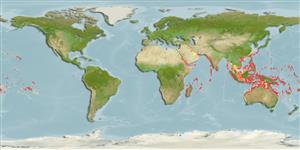Environment: milieu / climate zone / depth range / distribution range
Sinh thái học
Biển Cùng sống ở rạn san hô; Ở đại duơng, biển (Ref. 51243); Mức độ sâu 0 - 50 m (Ref. 128797). Tropical; 30°N - 34°S, 27°E - 134°W (Ref. 5222)
Indo-Pacific: Red Sea and east coast of Africa to French Polynesia. In the western Pacific it ranges from southern Japan to southern Queensland and Lord Howe Island. Often confused with Epinephelus fuscoguttatus.
Length at first maturity / Bộ gần gũi / Khối lượng (Trọng lượng) / Age
Maturity: Lm ?, range 58 - ? cm
Max length : 90.0 cm SL con đực/không giới tính; (Ref. 4319); common length : 90.0 cm TL con đực/không giới tính; (Ref. 5450)
Các tia vây lưng cứng (tổng cộng): 11; Các vây lưng mềm (tổng cộng): 14-15; Tia cứng vây hậu môn 3; Tia mềm vây hậu môn: 8. This species is distinguished by the following characters: body depth 2.7-3.1 in SL; preopercle rounded, finely serrate; upper edge of operculum distinctly convex; rear nostril diameter about twice that of anterior nostril; gill rakers of first gill arch 8-10 + 15-1= 24-27; dorsal-fin spines third or fourth longest, 2.7-3.3 in HL and distinctly shorter than longest dorsal-fin ray; 2-3 rows of teeth on midlateral part of lower jaw; front of jaws with inconspicuous fixed canines; body scales ctenoid in broad zone on side from beneath pectoral fin to caudal peduncle, the rest cycloid; caudal fin rounded; pectoral-fin rays 16-18, fin length 1.7-2.1 in HL; short pelvic fins, 1.9-2.4 in HL; lateral-line scales 47-52, in series 95-110. Colour of head, body, and fins pale brown, covered with small dark brown spots; upper half whitish, head and body with irregular dark blotches (more distinct on live specimens) superimposed over the dark spots; prominent black saddle blotch on caudal peduncle; dark spots extend all over head, including lower jaw, lips, branchiostegal membranes, gular area, and inside of mouth; numerous small white spots on fins (more distinct on live fish). a few on head and body; juveniles with a pair of blackish spots on each side of snout and a black spot at margin of second and third interspinous dorsal membranes (Ref. 39231, 89707, 90102).
Often found in coral-rich areas of lagoon and outer reefs; in caves and large crevices to swim through (Ref. 48635). Most abundant around islands, particularly atolls. Usually in small schools but may be solitary (Ref 90102). Feeds mainly on crustaceans (portunid crabs) and fishes, sometimes on cephalopods and gastropods. In the Hong Kong live fish markets (Ref. 27253). This species is important in artisanal fisheries, but occasionally implicated in cases of ciguatera (frequently ciguatoxic in the Marshall Is., Ref. 37816). It is now uncommon at localities with heavy spearfishing, but popular in the aquaculture industry of Singapore, where it is known as 'marble grouper'. It is caught with hook-and-line, spear, and traps (Ref. 39231).
Heemstra, P.C. and J.E. Randall, 1993. FAO Species Catalogue. Vol. 16. Groupers of the world (family Serranidae, subfamily Epinephelinae). An annotated and illustrated catalogue of the grouper, rockcod, hind, coral grouper and lyretail species known to date. Rome: FAO. FAO Fish. Synop. 125(16):382 p. (Ref. 5222)
IUCN Red List Status (Ref. 130435)
Threat to humans
Reports of ciguatera poisoning (Ref. 1602)
Human uses
Các nghề cá: Tính thương mại; Nuôi trồng thủy sản: thực nghiệm
Các công cụ
Special reports
Download XML
Các nguồn internet
Estimates based on models
Preferred temperature (Ref.
123201): 24.5 - 28.9, mean 27.6 °C (based on 698 cells).
Phylogenetic diversity index (Ref.
82804): PD
50 = 0.5000 [Uniqueness, from 0.5 = low to 2.0 = high].
Bayesian length-weight: a=0.01202 (0.01065 - 0.01357), b=3.04 (3.02 - 3.06), in cm total length, based on LWR estimates for this species (Ref.
93245).
Mức dinh dưỡng (Ref.
69278): 4.0 ±0.5 se; based on diet studies.
Thích nghi nhanh (Ref.
120179): thấp, thời gian nhân đôi của chủng quần tối thiểu là 4.5 - 14 năm (Preliminary K or Fecundity.).
Fishing Vulnerability (Ref.
59153): Moderate vulnerability (42 of 100).
Climate Vulnerability (Ref.
125649): Very high vulnerability (79 of 100).
Nutrients (Ref.
124155): Calcium = 20.2 [10.0, 44.3] mg/100g; Iron = 0.434 [0.232, 0.894] mg/100g; Protein = 18.7 [17.2, 20.1] %; Omega3 = 0.11 [0.07, 0.18] g/100g; Selenium = 37.6 [22.1, 68.3] μg/100g; VitaminA = 137 [38, 494] μg/100g; Zinc = 1.1 [0.8, 1.6] mg/100g (wet weight);
